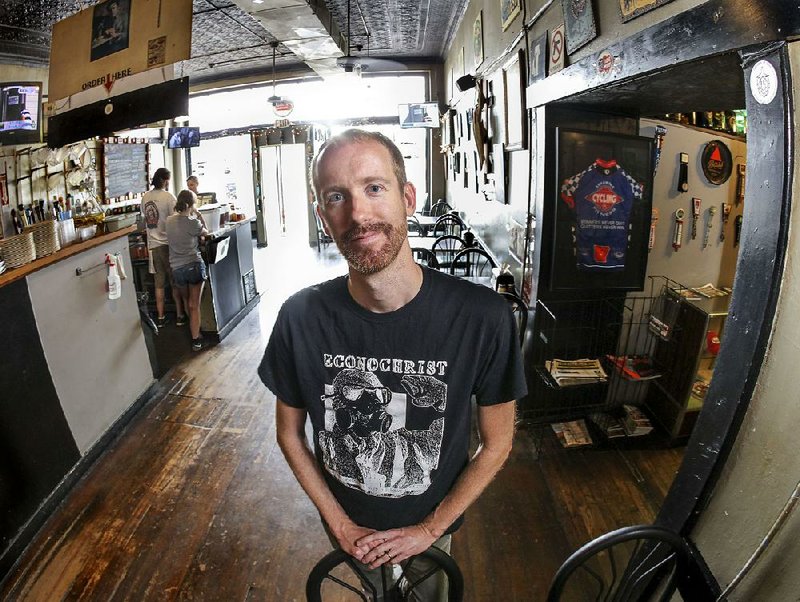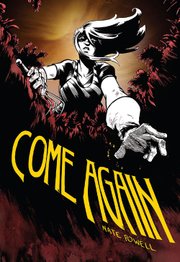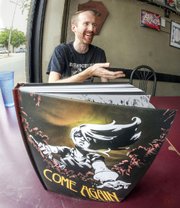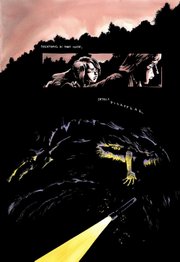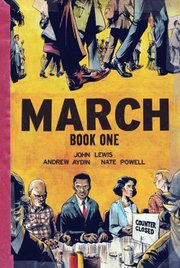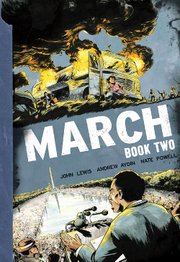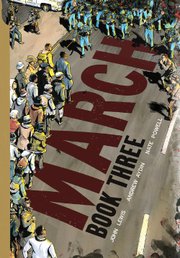After winning a National Book Award for March: Book Three, the third installment in the graphic novel memoir of Georgia congressman and civil rights leader John Lewis, cartoonist Nate Powell has returned to his trippy, magical and sometimes scary world of fiction.
Come Again, his new graphic novel which will be released in comic book stores on Wednesday and on Aug. 7 in other bookstores, is also a return to Arkansas.
"I was looking for a place that I knew, but that also seems like it's another planet, and I was like, 'The Ozarks,'" he says.
Set in the late '70s in the fading, fictional, hippie village of Haven Station -- a back-to-the-land, "community of intention" near a town called Hallelujah Springs in the Ozarks -- Powell's story, which he drew and wrote, revolves around secrets, desire, parenthood and the meaning of freedom. There's also collective amnesia, a rock band, a missing child and an unseen monster/haint lurking in a secret cave.
It's like the Twilight Zone in the Ozarks, illustrated gorgeously by Powell's flowing, cartoon-realism style, panels of haunting, heavily inked, chiaroscuro and unique lettering.
Van Jensen, the former Arkansas Democrat-Gazette reporter who now writes for comic books such as Green Lantern and The Flash as well as co-creating the Pinocchio, Vampire Slayer series with artist and fellow Democrat-Gazette alumnus Dusty Higgins, is a longtime Powell fan.
"The humanity of Nate's art leaps off the page," Jensen writes in an email from Atlanta. "He's heavy with ink, which I love. Then it's an absolutely perfect midpoint of cartooning and realism, but all with its own flavor. I saw that from the first page I ever read, and he's only gotten better with every page since."
...
It's a typically humid June afternoon in Little Rock and Powell, a rail-thin vegetarian, is having a slice of cheese pizza at Vino's, the restaurant/rock club where he played many a set with his DIY punk band, Soophie Nun Squad.
"Vino's is still in my top three slices of pizza in the country," he declares.
Powell, who lives in Bloomington, Ind., with wife Rachel and their two daughters, ages 6 and 3, is in Arkansas to give the keynote address at the Arkansas Governor's School at Hendrix College in Conway.
He has been drawing and making comics for most of his life. Growing up in North Little Rock, Powell began creating superhero comic books with his friend and fellow artist Mike Lierly and selling copies at the Collector's Edition Comics store.
"Mike was the first person who actually uttered the words 'We should make comics together,'" Powell says. "I never looked back."
After graduating from North Little Rock High School in 1996, he attended the School of Visual Arts in New York, where he discovered underground comics and a world beyond caped superheroes.
"I was coming out of Arkansas and had a thirst for storytelling that was outside of what I had grown up enjoying," he says.
Soophie Nun Squad was still a major part of his life and kept him connected with his friends and Little Rock until the band, which at times had 11 members, finally shut down in 2006.
"It became the tractor beam that drew us back to Arkansas and kept us in each other's lives," Powell says. "It also became the central device by which we structured all of our lives. It had to do with being here at every school holiday, all summer breaks, all of your jobs and other commitments revolved around being able to play shows, record, tour and make things."
To make ends meet, he worked providing support for adults with developmental disabilities. All the while, he was drawing and writing comics, many of them telling more personal stories. In 2008, his longest work yet, the 216-page graphic novel Swallow Me Whole, was published.
It is a sensitive, moving, dreamlike portrayal of mental illness and familial relationships that was widely praised, winning two Ingnatz Awards and a prestigious Eisner Award for best original graphic novel. By 2009, Powell was a full-time cartoonist.
He was finishing work on Any Empire, his 2011 follow-up to Swallow Me Whole, and The Silence of Our Friends, a collaboration with Mark Long and Jim Demonakos, when he got wind from his publisher, Top Shelf Productions, about Lewis' graphic novel memoir project.
"I was vaguely familiar with John Lewis at the time and thought it looked like a really cool project," he says, but the idea of working on the book didn't occur to him.
"A couple of weeks later my publisher called and strongly suggested I try out."
...
The March trilogy tells the story of Lewis, the 78-year-old Democrat from Georgia who has served in Congress since 1987. As a college student he was chairman of the Student Nonviolent Coordinating Committee and was part of the 1963 March on Washington, where Martin Luther King Jr. delivered his famous "I Have a Dream" speech and where Lewis was the youngest speaker.
While protesting peacefully to end legalized racial segregation in the South in the '60s, the Alabama-born Lewis was often beaten and jailed.
Atlanta native Andrew Aydin is a comic book fan who had spent the summer of 2008 working as Lewis' press secretary on his re-election campaign. On the campaign trail, he heard the congressman talk about his role in the civil rights movement.
"I got to listen to him tell all these stories to kids about his life, stories I'd never heard growing up, even though I lived in his district and went to Atlanta public schools," Aydin says in a phone call from Washington.
Inspired by the 16-page 1957 comic book Martin Luther King and the Montgomery Story, which was recommended to him by Lewis, Aydin began pushing for Lewis to tell his story in graphic novel form.
"I said that if you want to teach young people about John Lewis, about the movement, about civil rights, you should do a comic book," Aydin recalls. "Everybody looked at me like I had three heads."
Lewis eventually agreed to the project, but only if Aydin would write the book with him, so Aydin got to work not only writing but pitching the book proposal to publishers. Two years later, Top Shelf agreed to publish Lewis' memoir and Powell submitted art as a tryout to become the book's illustrator.
After his initial submissions, Powell, who draws on Bristol board with a nib pen and brush, produced a second set of drawings, which incorporated a gray wash he hadn't used before.
"It was the first time I'd seen him do that," says Aydin, who is now Lewis' digital director and policy adviser. "Once I saw that second set of pages, I went to the congressman and said, 'This is it.'"
Originally planned as one massive opus, March was divided into three volumes after Powell and Aydin realized that a single book might be a bit unwieldy, never mind the deadline implications.
"We decided to break it up at its natural story points to take the stress off," Powell says. "And fourth- or sixth-graders aren't going to read a 600-page brick. It would have been this impenetrable volume."
March: Book One was published in 2013, followed by Book Two in 2015 and Book Three in 2016. The trilogy became a best-seller and has been taught in middle schools and high schools in more than 40 states.
The riveting conclusion, Book Three, became the first graphic novel to win a National Book Award.
The awards ceremony took place in New York a week after the 2016 presidential election.
"It was really important to be around Andrew and Congressman Lewis at that time," Powell says, "Once we got to the ceremony, it was a room full of literary people and the vibe in the room was one that embraced ideas and community. It was positive and therapeutic, regardless of the [awards] outcome."
Their category, Young People's Literature, was the first to be announced, and when they realized they had won, the emotions hit.
"Within a couple of minutes, everyone was crying," Powell says.
Powell talks about how March affected his approach to his own stories, how he started using those washes and scaling back the meticulous hatching he once favored in his art, and how telling Lewis' story improved the clarity of his writing. Working with Lewis and seeing the civil rights icon's commitment firsthand also left a lasting impression, which he shares with his daughters.
"He's a very reassuring, temperate, visionary human being," Powell says. "In the past year-and-a-half it's been important to emphasize John Lewis' basic philosophies and mandates, especially to a 5- or 6-year-old. When you see something that is not right, that is not just, you have to stand up, speak up, speak out. It's been one of the shining lights in my life, to impart this stuff."
Powell contributed 10 pages of art to Run: Book One, the sequel to the March trilogy, which is scheduled to be published Oct. 16.
After years spent working on nonfiction, Powell was ready to return to a world of his own making, which resulted in the 272-page Come Again.
"The earliest seeds of Come Again were actually sown here in Arkansas, on a Christmas break in 2007," he says.
Powell, Lierly and their buddy, Nathan Wilson, were in Hot Springs, brainstorming ideas about a new comic book.
"We drank a bunch of caffeine, just like when we were 12, and got started on this high-minded, otherworldly sci-fi fantasy story."
Over the years, Lierly, now an artist in Los Angeles, and Wilson, who works for Google, lost interest and Powell picked out a few threads that interested him and began tweaking those components. He also wanted it set in Arkansas and it has a connection to the Wormwood community, Powell's fictionalized version of Little Rock where he set Swallow Me Whole and Any Empire.
The story is told from the point of view of Haluska, a single mother in the dwindling village of Haven Station.
Most of the themes in his books are more questions than answers, Powell says, and this time around the theme "is what do you do when you see that your ideals don't meet up with where your life is, or what do you do when your life has worked out for you, but it's not the thing you believe in, it's not the thing you would have chosen, but you still like your life?"
There's also a creepy-crawly factor at play with a hidden creature tormenting Haluska from a secret cave. The spirit has roots not only in Ethiopian and Gaelic tales, but also in Arkansas ghost stories like the Woodson-Lateral Light and Mama Lou and the Wolf Bayou Bridge.
"I believe the Woodson-Lateral ghost is a real thing," Powell says of the legend of mysterious lights that follow drivers on the rural road south of Little Rock before suddenly disappearing. "I've seen it and it was a very harrowing thing."
He also says a North Little Rock house where he and his friends often gathered when he was growing up had a poltergeist that was "very influential in our lives."
These unexplained experiences were also a impetus for Come Again, which is dedicated to the late science fiction author Ursula K. Le Guin and is Powell's first graphic novel to use color.
"I've always had this stuff floating around in my life, and I wanted to lean into that," he says.
Aydin read an early draft of the story and sums it up as vintage Powell.
"I think it's spectacular," he says. "It's Nate being weird Nate again, which is great. If you like Swallow Me Whole and Any Empire, this is a book for you."
Next up, Powell has teamed with Jensen for Two Dead, a true story based in Little Rock that Jensen uncovered in his reporting days. As with Come Again, it has been percolating awhile. The two started talking about it in 2010 at the annual San Diego Comic Con.
"We were hanging out, and I mentioned this bizarre historical story I'd found," Jensen remembers. "I knew Nate would like it, given that it delves into mental health and the way it could touch on segregation and the dangers of policing when it fails."
The story was first meant to be in regular, serialized comic book form, but it has now grown into a graphic novel.
"I'm currently redrawing it and hurriedly trying to finish it for next year," Powell says.
Style on 07/08/2018

